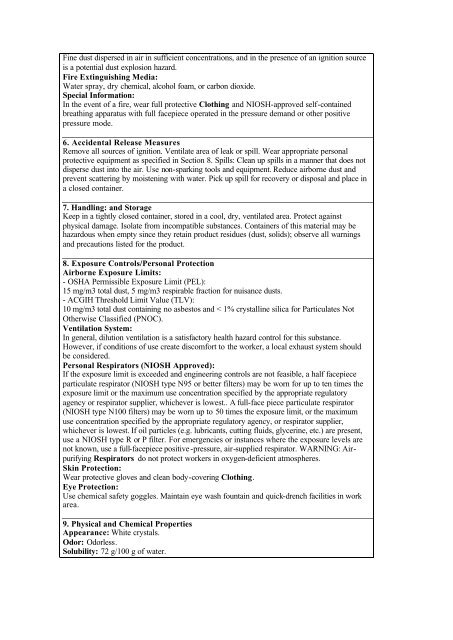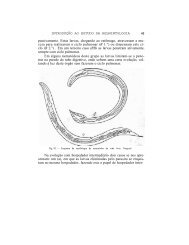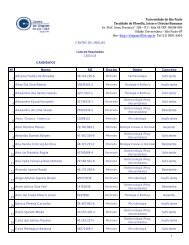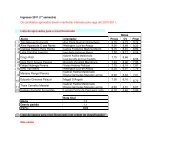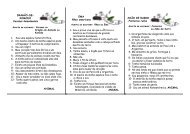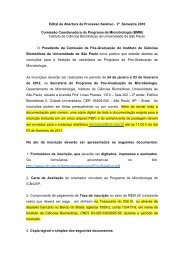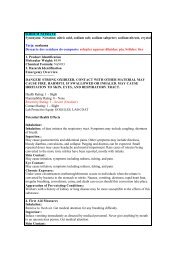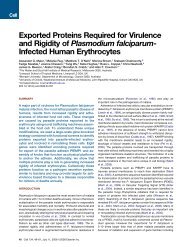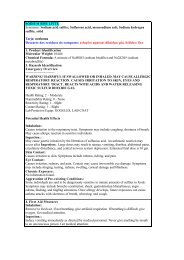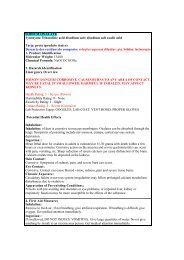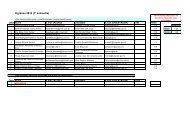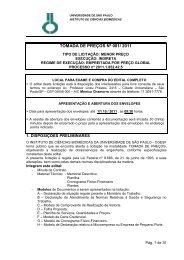SODIUM CITRATE Synonyms: Citrosodine; trisodium citrate ... - USP
SODIUM CITRATE Synonyms: Citrosodine; trisodium citrate ... - USP
SODIUM CITRATE Synonyms: Citrosodine; trisodium citrate ... - USP
You also want an ePaper? Increase the reach of your titles
YUMPU automatically turns print PDFs into web optimized ePapers that Google loves.
Fine dust dispersed in air in sufficient concentrations, and in the presence of an ignition source<br />
is a potential dust explosion hazard.<br />
Fire Extinguishing Media:<br />
Water spray, dry chemical, alcohol foam, or carbon dioxide.<br />
Special Information:<br />
In the event of a fire, wear full protective Clothing and NIOSH-approved self-contained<br />
breathing apparatus with full facepiece operated in the pressure demand or other positive<br />
pressure mode.<br />
6. Accidental Release Measures<br />
Remove all sources of ignition. Ventilate area of leak or spill. Wear appropriate personal<br />
protective equipment as specified in Section 8. Spills: Clean up spills in a manner that does not<br />
disperse dust into the air. Use non-sparking tools and equipment. Reduce airborne dust and<br />
prevent scattering by moistening with water. Pick up spill for recovery or disposal and place in<br />
a closed container.<br />
7. Handling: and Storage<br />
Keep in a tightly closed container, stored in a cool, dry, ventilated area. Protect against<br />
physical damage. Isolate from incompatible substances. Containers of this material may be<br />
hazardous when empty since they retain product residues (dust, solids); observe all warnings<br />
and precautions listed for the product.<br />
8. Exposure Controls/Personal Protection<br />
Airborne Exposure Limits:<br />
- OSHA Permissible Exposure Limit (PEL):<br />
15 mg/m3 total dust, 5 mg/m3 respirable fraction for nuisance dusts.<br />
- ACGIH Threshold Limit Value (TLV):<br />
10 mg/m3 total dust containing no asbestos and < 1% crystalline silica for Particulates Not<br />
Otherwise Classified (PNOC).<br />
Ventilation System:<br />
In general, dilution ventilation is a satisfactory health hazard control for this substance.<br />
However, if conditions of use create discomfort to the worker, a local exhaust system should<br />
be considered.<br />
Personal Respirators (NIOSH Approved):<br />
If the exposure limit is exceeded and engineering controls are not feasible, a half facepiece<br />
particulate respirator (NIOSH type N95 or better filters) may be worn for up to ten times the<br />
exposure limit or the maximum use concentration specified by the appropriate regulatory<br />
agency or respirator supplier, whichever is lowest.. A full-face piece particulate respirator<br />
(NIOSH type N100 filters) may be worn up to 50 times the exposure limit, or the maximum<br />
use concentration specified by the appropriate regulatory agency, or respirator supplier,<br />
whichever is lowest. If oil particles (e.g. lubricants, cutting fluids, glycerine, etc.) are present,<br />
use a NIOSH type R or P filter. For emergencies or instances where the exposure levels are<br />
not known, use a full-facepiece positive -pressure, air-supplied respirator. WARNING: Airpurifying<br />
Respirators do not protect workers in oxygen-deficient atmospheres.<br />
Skin Protection:<br />
Wear protective gloves and clean body-covering Clothing.<br />
Eye Protection:<br />
Use chemical safety goggles. Maintain eye wash fountain and quick-drench facilities in work<br />
area.<br />
9. Physical and Chemical Properties<br />
Appearance: White crystals.<br />
Odor: Odorless.<br />
Solubility: 72 g/100 g of water.<br />
Density: ca. 1.7


